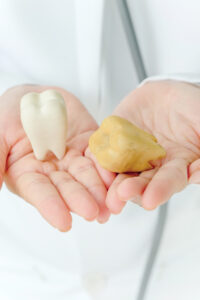When we think about our teeth, we often consider them as strong, healthy structures that help us chew and smile. But sometimes, teeth can become damaged or unhealthy. One serious condition is when a tooth becomes “dead.” But what does it mean when a tooth is dead? In this article, we’ll explore what a dead tooth is, how it happens, what it feels like, and what you can do about it.
What Is a Dead Tooth?
A dead tooth is a tooth that has lost its vitality, meaning the living tissue inside the tooth, called the pulp, is no longer healthy. The pulp contains nerves, blood vessels, and connective tissue, and it is responsible for keeping the tooth alive. When the pulp dies, it can lead to several problems, including pain, infection, and the potential loss of the tooth itself.

Dead teeth can happen for various reasons, including:
- Tooth Decay: Severe cavities can reach the pulp and cause it to become infected or die.
- Trauma: An injury to the tooth, such as a hard hit during sports or an accident, can damage the pulp.
- Gum Disease: Periodontal disease can lead to infection around the tooth and affect the pulp.
Does a Dead Tooth Have to Be Removed?
One of the most common questions people have about dead teeth is whether they need to be removed. The answer depends on the condition of the tooth and the surrounding area. Here are a few points to consider:
- If the Tooth Can Be Saved: In many cases, a dead tooth can be treated without removal. A dentist may perform a procedure called root canal therapy to remove the dead pulp and clean out the inside of the tooth. After the pulp is removed, the dentist will fill the empty space with a special material and seal the tooth. This allows the tooth to stay in place and function normally.
- If the Tooth Is Severely Damaged: If the tooth is too damaged or has a significant infection, it may need to be extracted. Your dentist will evaluate the condition of the tooth and recommend the best option for your situation.
- After Extraction: If removal is necessary, the dentist may discuss options for replacement, such as a dental implant or bridge, to restore function and appearance.
Can You Fix a Dead Tooth?
Yes, in many cases, you can fix a dead tooth. Here are the main options available for treatment:
- Root Canal Therapy: This is the most common procedure for treating a dead tooth. During a root canal, the dentist will remove the dead or infected pulp, clean the inside of the tooth, and fill it with a special material to prevent further infection. After the procedure, a crown may be placed on the tooth to provide additional support and protection.
- Dental Crowns: After a root canal, the tooth can become brittle, so a crown is often recommended to protect it. The crown covers the tooth and helps restore its strength and function.
- Monitoring: Sometimes, if the tooth is not causing any issues, the dentist may monitor it for changes. Regular check-ups will help ensure that any problems are caught early.
Is a Dead Tooth a Rotten Tooth?
People often wonder if a dead tooth is the same as a rotten tooth. While there are similarities, they are not exactly the same:
- Rotten Tooth: A rotten tooth usually refers to a tooth that has significant decay and may have visible holes or dark spots. It indicates that the tooth structure is breaking down due to untreated cavities. A rotten tooth can lead to pulp death if the decay reaches the pulp.
- Dead Tooth: A dead tooth specifically refers to the pulp inside the tooth that has died, regardless of how much decay there is on the outside. A tooth can be dead without being visibly rotten if it has internal damage or infection.
In summary, while a dead tooth can result from a rotten tooth, not all dead teeth are visibly rotten.
Does a Dead Tooth Stink?
Yes, a dead tooth can sometimes produce an unpleasant odor. Here’s why this might happen:
- Bacterial Infection: When the pulp dies, it can lead to an infection. Bacteria can thrive in the dead tissue and produce foul-smelling gases. This can result in bad breath or a bad taste in your mouth.
- Abscess Formation: If the infection spreads, it can form an abscess (a pocket of pus) at the root of the tooth. An abscess can cause swelling, pain, and a strong odor.
If you notice a bad smell coming from your mouth, especially if it’s associated with a painful or discolored tooth, it’s essential to see a dentist as soon as possible.
Signs and Symptoms of a Dead Tooth

Recognizing the signs of a dead tooth is important for seeking timely treatment. Here are some common symptoms to look out for:
- Pain: You may experience sharp, throbbing, or persistent pain in the affected tooth or surrounding areas.
- Sensitivity: A dead tooth can become sensitive to hot or cold temperatures, often leading to discomfort.
- Discoloration: The dead tooth may appear darker or grayish compared to surrounding teeth.
- Swelling and Redness: The gums around the dead tooth may become swollen and tender.
- Bad Breath: If an infection is present, you may notice a foul smell or taste in your mouth.
If you experience any of these symptoms, it’s crucial to consult a dentist for an evaluation.
How to Prevent a Dead Tooth
While not all cases of dead teeth can be prevented, there are steps you can take to reduce your risk:
- Maintain Good Oral Hygiene: Brush your teeth at least twice a day and floss daily to remove plaque and food particles.
- Regular Dental Check-ups: Visit your dentist regularly for cleanings and exams. Early detection of cavities or gum disease can prevent tooth problems from becoming severe.
- Protect Your Teeth: If you play contact sports, consider wearing a mouthguard to protect your teeth from injury.
- Avoid Hard Foods: Be cautious with hard candies, ice, and other hard foods that can crack or damage your teeth.
- Limit Sugary Foods and Drinks: High sugar intake can lead to tooth decay, so try to limit sugary snacks and drinks.
Conclusion
In summary, a dead tooth is a tooth that has lost its vitality due to issues like trauma, decay, or infection. While it can often be treated with root canal therapy, sometimes extraction is necessary. Recognizing the signs of a dead tooth, such as pain, discoloration, and bad breath, is crucial for seeking timely dental care.
If you suspect you have a dead tooth or notice any troubling symptoms, don’t hesitate to contact your dentist. They can evaluate your condition and recommend the best course of action. By maintaining good oral hygiene and visiting your dentist regularly, you can help protect your teeth and keep your smile healthy.


